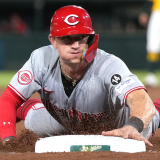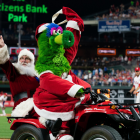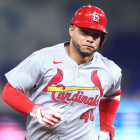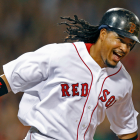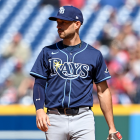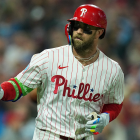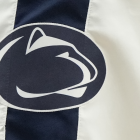MLB prospect rankings: Top 25 players re-ranked with Jackson Holliday, Elly De La Cruz at the top
Here are the best prospects in baseball nearing the halfway point of the 2023 season

Believe it or not, Major League Baseball's amateur draft is just over a month away (as has become the custom, it will coincide with the beginning of the All-Star Break on Sunday, July 9). CBS Sports will soon begin offering comprehensive coverage of this year's event, including breaking down the top 30 prospects in the class.
Before we shift our focus to the future professional ballplayers of the land, we wanted to provide an update to our universal minor-league prospect rankings. As such, we've spent the last couple of weeks watching video, digging into statistics, and talking to scouts, analysts, and other talent evaluators in and around the industry to provide a refreshed top 25 list heading into the draft. (We'll expand to 30 after the draft.)
Keep in mind that in order to have eligibility for this list, a player must not have more than 130 at-bats or 50 innings pitched in the majors. Additionally, they must not have exceeded 45 days of service on a big-league roster. Those parameters are defined by MLB, not us. If a notable youngster is absent -- think Grayson Rodriguez or Francisco Álvarez -- it's likely because they cleared those parameters.
As always, this is more of an art than a science. If you disagree with a ranking, that's fine. Even the professionals get this stuff wrong often. Now, with all the fine print out of the way, let's get to the good stuff.
1. Jackson Holliday, SS, Orioles (High-A)
Holliday, the No. 1 pick in last year's draft, has more than justified the selection. Despite playing the entire season at 19 (making him several years younger on average than his competition), he's already conquered both levels of A-ball with ease.
With another multihit effort, MLB's No. 3 prospect Jackson Holliday (@Orioles) caps an incredible series for the @IronBirds:
— MLB Pipeline (@MLBPipeline) May 21, 2023
5 G
13 H
8 XBH
3 BB
14 RBI
9 R
2 SB pic.twitter.com/NPv5vkdolc
Holliday has middle-of-the-order offensive upside, complete with the ability to hit for average and power alike, as well as middle-of-the-infield defensive skills. (The Orioles have cross-trained him at second base to bolster their options.) A veteran talent evaluator said that Holliday is so far ahead of the pack that, if they could, they would trade their club's two best prospects (both well-regarded in their own right) for him. Holliday should soon move up to Double-A. MLB ETA: Spring 2024
2. Elly De La Cruz, SS, Reds (MLB)
De La Cruz was promoted to the majors by the Reds just hours after this list was initially published. His MLB debut is heavily anticipated for good reason. Since returning from a hamstring injury in late April, the switch-hitting De La Cruz pummeled Triple-A pitching and produced some of the loudest contact that organized baseball will see all year. Lest that read like hyperbole, his feats of strength so far this season include more than a handful of batted balls with exit velocities north of 115 mph.
For the 9th time this year, top-ranked @Reds prospect Elly De La Cruz has liftoff 🚀
— MLB Pipeline (@MLBPipeline) May 26, 2023
The 21-year-old phenom has amassed a 1.023 OPS for the @LouisvilleBats.
Watch what he does next FREE: https://t.co/aKtGFgWBY3 pic.twitter.com/AhtREXvC8j
De La Cruz has elite power, in other words, as well as near-elite speed. (In one game this season, he stole third base without a throw when a catcher made a lackadaisical return toss to the pitcher.) Scouts have warmed up to De La Cruz remaining at shortstop, but they haven't yet gotten over his swing-and-miss tendencies, particularly against left-handed pitching. There's a fair chance that he ends up being a nominal switch-hitter who does most of his damage versus righties. That's fine, all things considered, since De La Cruz still has one of the highest ceilings in baseball. MLB ETA: Called up Tuesday
3. Eury Pérez, RHP, Marlins (MLB)
Pérez entered the spring ranked as the second-best pitcher in the minors. He's now the top prospect-eligible arm, and while he's worthy of the honor, it's one that he came into almost by default: Grayson Rodriguez graduated on service time; Andrew Painter, Daniel Espino, and Ricky Tiedemann sustained injuries; and Kyle Harrison has suffered a control-related setback. Pérez recently made his big-league debut, showing off a four-pitch mix that includes an upper-90s fastball and two swing-and-miss breaking balls.
“I told them I have new shoes, so please be careful with my shoes."
— MLB Pipeline (@MLBPipeline) May 19, 2023
Top @Marlins prospect Eury Pérez had fun with his teammates after earning his first MLB victory on Thursday: https://t.co/Wj4q7sZAGk pic.twitter.com/o2htNIzHYW
Take his stuff and add in how he's always shown better command than you'd expect for someone of his youth (he turned 20 in April) and height (6-foot-8), and there's a real chance that he develops into an All-Star-caliber starter in the near future. MLB ETA: Already debuted
4. Marcelo Mayer, SS, Red Sox (Double-A)
Mayer was ranked by CBS Sports as the top prospect available heading into the 2021 draft, but he ended up sliding to the Red Sox at No. 4. We think it's fair to assume that they're happy with how that worked out. Mayer has opened this season back in High-A, where he's improved upon his play from last year by cutting into his strikeout rate and upping his overall production.
Hello. The bosses give admin time with admin's family and friends during away weeks. But, admin needed to interrupt the timeline to let you know the Drive are winning 9-0.
— Greenville Drive (@GreenvilleDrive) May 24, 2023
Oh and Marcelo Mayer has two dingers tonight👇 pic.twitter.com/CMiCOB9OSB
His game is likely to elicit comparisons to Corey Seager and Brandon Crawford, depending on where he lands on the contact-power spectrum -- you can make an educated guess on his preference based on how he's prioritized lifting and pulling the ball more frequently this season. Defensively, he atones for below-average footspeed with great instincts and a strong arm. Those traits should allow him to remain at shortstop for the long haul. MLB ETA: Summer 2024
5. Jordan Walker, OF, Cardinals (Triple-A)
Walker beat long odds back in the spring, forcing his way onto the Cardinals' Opening Day roster even though he was only 20 years old (he's since turned 21) and had zero career Triple-A at-bats. His introduction to the majors didn't go well enough for him to avoid a late April demotion, however, and he's since scuffled in his return to the minors. Nevertheless, Walker remains a promising young hitter with home-run champion potential.
JORDAN WALKER'S 1ST CAREER HOME RUN! pic.twitter.com/xxi9sVba1G
— St. Louis Cardinals (@Cardinals) April 5, 2023
The short-form description of his game remains unchanged: he has immense strength, he just needs to improve his swing plane. Those inside the game believe it's easier to teach a batter to elevate than it is to impact the ball. It's up to Walker, like Vladimir Guerrero Jr. and others before him, to validate that notion. MLB ETA: Already debuted
6. Jackson Chourio, OF, Brewers (Double-A)
Chourio was the breakout star of the 2022 minor-league season, blazing his way through three levels en route to a combined 20 home runs and 16 stolen bases. We feel it's important to note upfront that he will not celebrate his 20th birthday until next spring. Why? Because it helps contextualize his struggles this year in Double-A. He's fanning a lot and not producing in the way that made him a top-five prospect entering the spring. To be fair, talent evaluators had expressed concerns about Chourio's hit tool even dating back to last year, making him one of the prospects with the widest set of error bars. The hope is that he makes just enough contact for his near-elite power and speed combination to turn him into a star. Stay tuned. MLB ETA: Late 2024
7. James Wood, OF, Nationals (Double-A)
Wood, who stands 6-foot-6, has had an eventful two years. Although his game featured elite raw power and better-than-expected athleticism for his size, he slipped to the late second round in 2021 because of how frequently he whiffed that summer. He then came out last year, his first full pro season, and made far more contact than expected through his initial 50 games. That's when the Padres shipped Wood to the Nationals as part of the Juan Soto trade. Since then, his strikeout rate has ballooned to over 27% -- or, closer to where scouts anticipated it would be on draft night. While Wood's strength and plate discipline gives him a good base (one that could transfer into star-level production), there's always a fear with tall hitters that their swings will become unruly and exploitable by advanced pitching. He's now arriving in Double-A, the most important proving ground for a hitting prospect. We'll see if Wood can keep his strikeout rate on the sunny side of 30% there. MLB ETA: Late summer 2024
8. Andrew Painter, RHP, Phillies (Injured list)
Unfortunately for both Painter and the Phillies, the 20-year-old starter hasn't pitched since straining his ulnar collateral ligament in the spring. Yes, that's the ligament associated with Tommy John surgery; no, he hasn't gone under the knife. He's instead attempted to remedy his condition with rest. (A good approach for all of life's ills.) If Painter had stayed healthy, he would've already debuted on the strength of a broad arsenal, including a power fastball-slider combination. He's resumed throwing and the Phillies have maintained that they envision him pitching, perhaps even in the majors, before the end of the season. Here's hoping. MLB ETA: Late 2023, maybe
9. Evan Carter, OF, Rangers (Double-A)
Carter is a good reminder that overreacting on draft night is a fool's errand. The Rangers shocked the industry by selecting him in the second round in 2020. It's clear now that they were wise to do so. He hadn't been on everyone's map, but those familiar with him reported that he was a promising player whose upward trajectory was halted by the pandemic.
Evan Carter walks it off with his fourth hit of the night!! pic.twitter.com/qIRnofFRwM
— Frisco RoughRiders (@RidersBaseball) May 21, 2023
Carter has since proved as much on the field, showing off a well-rounded game that allows him to hit for average and control the strike zone while playing a good center field and contributing plenty of stolen bases. Given his performance and the Rangers' success to date, he just might debut later this year. MLB ETA: Late 2023 or early 2024
10. Jordan Lawlar, SS, Diamondbacks (Double-A)
As an amateur, Lawlar often elicited comparisons to Royals shortstop Bobby Witt Jr. because of the similarities in their profiles (both were older prepsters with good power and defense projections) and the 30-minute drivetime between their hometowns. Whereas Witt treated Double-A like a minor challenge on his way to the majors, Lawlar has scuffled there dating back to last season. We're not ready to hit the panic button yet for a few reasons. Foremost, it's an aggressive assignment that has him playing against competition that's on average five years older than him, and with a grip-enhanced ball that has caused the offensive environment to go haywire. Lawlar also performed well in the Arizona Fall League last year, and he still has the physical traits that had evaluators envisioning him as an All-Star-caliber player not too long ago. We're OK giving him more time to figure out things. MLB ETA: Summer 2024
11. Ricky Tiedemann, LHP, Blue Jays (Double-A)
Tiedemann, a low-slot lefty with a promising three-pitch mix, was Toronto's third-round pick in 2021 by way of a junior college. That selection looks like a steal, though there's plenty of the book left to be written. Tiedemann reached Double-A late last season despite having just 78 professional innings to his name. He didn't have a chance to add many more this season (12) before requiring an injured list stint because of biceps inflammation. Tiedemann's utter lack of a track record makes this a risky rank justified by his impressive upside. MLB ETA: Spring 2024
12. Colson Montgomery, SS, White Sox (Injured list)
Montgomery has drawn comparisons in the past to Rangers shortstop Corey Seager, and it's not just because the two share facial structures and builds. The idealized outcome here has him maturing into a slugging shortstop with a good feel for contact. Montgomery probably isn't going to follow directly in Seager's cleat prints -- to wit, Seager made his MLB debut at 21, while Montgomery hasn't yet played since turning 21 in February because of oblique and back injuries -- but he has a chance to debut in the majors over the next calendar year and to become a good player in his own right. MLB ETA: Spring 2024
13. Taj Bradley, RHP, Rays (MLB)
The Rays' plethora of rotation injuries have afforded Bradley a better (and earlier) opportunity to plant his flag on the big-league staff than expected. He's taken advantage so far, even if he had to return to the minors in order to get on an every-fifth-day throwing schedule. Bradley does most of his work with two pitches: a mid-90s fastball with big-time vertical break and a cutter. He also throws another breaking ball and a changeup.
👏 @TajBradley 👏
— Tampa Bay Rays (@RaysBaseball) April 19, 2023
Well done once again pic.twitter.com/nVe0HYYWaT
Pitch-grading models quite like the cambio's profile, though it's lacking usability at this point since it too often ends up high and wide to his arm side. Bradley is only 22 years old (he was 17 on draft day), suggesting that he has plenty of time for it to click and for him to become at least a mid-rotation starter. MLB ETA: Already debuted
14. Jackson Merrill, SS, Padres (High-A)
Merrill had as much helium as any prospect heading into the 2021, canyoneering from relative unknown in the spring all the way to the 27th pick in the summer. His performance this season won't leap off the page, but it's important to bear in mind that he's young (he turned 20 in April) and that he missed part of last season with a wrist injury, costing him precious development time and reps against professional pitching. The upshot here remains a surefire shortstop with a great feel for contact, even if that contact often manifests itself in the form of grounders to the right side. MLB ETA: Spring 2025
15. Brooks Lee, SS, Twins (Double-A)
Lee was one of our favorite prospects in last year's draft: a heady, polished switch-hitter certain to remain on the infield. He fell to the Twins at No. 8, perhaps because of the concerns teams had about his so-so athleticism and medical history (he's dealt with knee and back problems). The Twins rushed him along to Double-A and he's held his own there, particularly against right-handed pitching. In an interesting twist, the Twins have continued to play him almost exclusively at shortstop. Most scouts who spoke to CBS Sports last summer believed Lee would be forced to move to second or third base. With Carlos Correa entrenched as Minnesota's shortstop, it certainly seems more likely than not that Lee will start taking reps elsewhere. His big-league debut probably won't trail far behind. MLB ETA: Late 2023 or early 2024
16. Noelvi Marte, 3B/SS, Reds (Double-A)
We know, we know. Marte is all but certain to move to third base on a permanent basis sooner than later, and he's absolutely a streaky hitter. It's perfectly reasonable to be lower (arguably much lower) on him than this. We just can't help ourselves because, bottom line, he's a 21-year-old infielder with oft-demonstrated contact and power chops.
Second pitch of the game? Noelvi Marte was all over it.
— MLB Pipeline (@MLBPipeline) May 19, 2023
The No. 2 @Reds prospect slugs a homer for the second straight game for the @ChattLookouts: pic.twitter.com/ikhzyfCuxx
What's more is that Marte has continued to produce this season in Double-A, even while the league experiments with a tacked ball that has led to a depressed hitting environment. Our optimism about him may end up aging poorly, but, then, that's true of most prospect analysis. MLB ETA: Spring 2024
17. Junior Caminero, 3B/SS, Rays (Double-A)
We identified Caminero, who the Rays originally acquired from the Guardians for journeyman Tobias Myers, as a breakout candidate prior to the season. He's delivered so far, posting a ridiculous batting line against High-A competition that's three-plus years his senior. Caminero has one major concern facing him now that the matter of his long-term defensive home has been settled (he's mostly played third this year), and that's with respect to his approach. His strikeout rate has increased this year while his walk rate has remained static. Make no mistake about it: Caminero's youth and ability to impact the baseball bode well for his future prospects. We just suspect he will face more of a challenge in Double-A until he becomes more selective. MLB ETA: Summer 2025
18. Bobby Miller, RHP, Dodgers (MLB)
Miller, the 29th pick in 2020, has overhauled his mechanics since joining the Dodgers. Most notably, he's truncated his arm stroke and improved his direction to the plate. Miller always had premium stuff, dating back to his days at Louisville. He still does, as evidenced by his big-league debut, when his fastball averaged 99 mph and featured perfect spin efficiency, according to Statcast. The bigger question for Miller is workload. The Dodgers were conservative with their usage of him in the minors, resulting in him reaching the majors having averaged just four innings per pop. The Dodgers have a reason for everything they do, and the innings expectations for starting pitchers have shifted in recent years, but it remains hard to wrap one's head around the idea that a potential impact starter might pitch 120-140 innings by design. MLB ETA: Already debuted
19. Henry Davis, C, Pirates (Triple-A)
The Pirates selected Davis with the top pick in the 2021 draft, yet he received only the fifth-highest signing bonus, with Pittsburgh funneling the savings to other parts of their class. There was nothing inherently wrong with that strategy since evaluators felt he was a defensible pick, but it hasn't revealed itself as a slam-dunk choice. That's in part because Davis was limited by injuries to just 67 games over his first season-plus as a professional. He's fared better this year, in health and performance, showing off the big-time power that made him so enticing to begin with. While the hope is that Davis remains tolerable behind the plate, it's perhaps noteworthy that the Pirates have given him more looks in right field this year, if only to preserve his body and help unlock his bat. It should go without writing that a move that far down the defensive spectrum would make Davis less interesting as a prospect. It should also go without writing that the Pirates will live with that reality if it means he's free to launch 30-plus home runs a year. MLB ETA: Late 2023 or early 2024
20. Druw Jones, OF, Diamondbacks (Low-A)
Jones was a legitimate candidate to go first in the 2022 draft up until the pick was announced. The Orioles instead went with Jackson Holliday, leaving Jones to go No. 2 to Arizona. So far that appears to have been the correct call by Baltimore. While Holliday has scorched the lower minors and solidified himself as the sport's top prospect, Jones has been limited to 10 regular season games. He injured his shoulder before making his professional debut, and then in late April suffered a quadriceps injury that has kept him sidelined. In theory, he could develop into a ballhawk who hits for average and power. In practice, he has to find a way to stay on the field for it to matter. MLB ETA: Summer 2025
21. Colton Cowser, OF, Orioles (Triple-A)
The Orioles have made four consecutive top-10 selections, a streak that will end this July after netting them Adley Rutschman (possibly the best catcher in baseball); Jackson Holliday (the best prospect in baseball); Heston Kjerstad (a candidate for this list after having his career delayed by myocarditis); and, yes, Cowser. His big-league debut appears imminent based on how well he's thrashed Triple-A pitching.
On the first pitch of the game, @CowserColton belted his 6th home run of the season!
— Norfolk Tides (@NorfolkTides) May 11, 2023
It's the third time this year he's led off a game with a home run 💪💪💪#RisingTide pic.twitter.com/sqHuCXmPG5
Cowser hits the ball hard and commands the strike zone as well as anyone in Triple-A. He's also an above-average runner who would be in line to play center if not for Cedric Mullins' continued presence on the Orioles roster. We will note that Cowser does have a substandard in-zone contact rate; we think the breadth of his skill set will allow him to overcome that defect and become a productive most-days starter all the same. MLB ETA: Imminent
22. Pete Crow-Armstrong, OF, Cubs (Double-A)
The Cubs nabbed Crow-Armstrong from the Mets at the 2021 trade deadline in exchange for a half-season of Javier Báez. That's fitting because, in a very broad sense, the two have similar games. Both are high-quality defenders at premium positions who can slug and run and who have a tendency to post lean walk-to-strikeout ratios. Crow-Armstrong has made adjustments to his swing and approach since joining the Cubs that have him lifting and pulling the ball with abandon. He's been able to maximize his power output as a result, though it's seemingly capped the other components of his triple slash. To his credit, he's made it work so far in Double-A. Will it work as well in the majors? We'll see. His ability to impact the game in center and on the basepaths will grant him a wide berth. MLB ETA: Spring 2024
23. Diego Cartaya, C, Dodgers (Double-A)
The Dodgers seem to have found the formula for producing big-league catchers. There's Will Smith and Keibert Ruiz, and in time their player-development machine will spit out Cartaya and Dalton Rushing. Cartaya gets the nod here despite a poor introduction to Double-A thanks to his youth (he's 21) and above-average power. He's struggled with strikeouts and being overly pull-reliant (though less so this year) in the past. It's not overly shocking, then, that he's stumbled out of the gate. We're willing to give him more time to make the necessary adjustments given his upside. MLB ETA: Summer 2024
24. Masyn Winn, SS, Cardinals (Triple-A)
Double-A is supposed to be the Burning Blade Challenge for hitting prospects, which is why it's been surprising to see Winn succeed there only to stub his toe at Triple-A. Through his first 46 games, he had one of the lowest barrel rates at the level. Pitchers, in turn, are spamming him with strikes. That's not a great combination. We do think Winn will be OK in the long run. He's young (he's playing the entire season at age 21) and he has a track record of hitting. He also has a good foundation of physical traits: good speed, a great arm (he was a two-way prospect as an amateur), and a fast bat. Sometimes players just take a little time to adjust. The Cardinals will hope that's the case here. MLB ETA: Spring 2024
25. Kyle Harrison, LHP, Giants (Double-A)
Back in the spring, we noted that Harrison needed to demonstrate he could consistently throw strikes (he'd walked 4.3 per nine innings for his career) and work deeper into starts (4.4 innings per appearance). Much to our chagrin, that hasn't happened. In his first 10 starts this season, Harrison instead walked nearly a batter per inning and averaged just three frames per attempt. His mechanics will likely prevent him from having even decent command as he has a lengthy arm swing that sees his elbow creep up to his shoulder line, elongating his operation and forcing his arm to play catch-up to his body at foot strike. Harrison has thrown significantly more strikes lately than he did in April, and it's at least possible that the new Double-A ball is to blame. The Giants have to hold out hope that he can locate his fastball-slider tandem just often enough to stick as a volatile starter. MLB ETA: Late 2023 or early 2024






